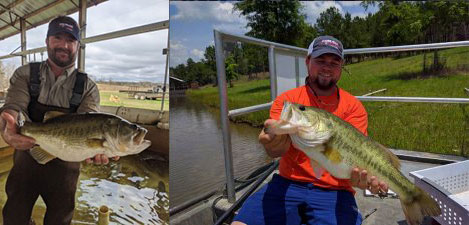A strain of aggressive hybrid bass, called tiger bass, are being stocked in one of the country’s most popular bass fishing lakes in the hopes that the fishery will start growing more trophy-sized fish.
Tiger bass are a hybrid strain of first-generation Florida bass crossed with northern bass, and almost 100,000 of them have been stocked in Oklahoma’s Grand Lake O’ The Cherokees, which is a 46,500-acre body of water near Tulsa. Tiger bass are touted as faster-growing than northern largemouth. Plus, they are more aggressive and thus easier to catch than pure Florida-strain largemouth.
For that reason, private donors have pooled enough cash to buy 93,000 tiger bass fingerlings from Alabama’s American Sport Fish Hatchery in Alabama, according to a June 20 Facebook post by the Oklahoma Department of Wildlife Conservation.
While Grand Lake is considered one of America’s top largemouth spots, it isn’t known for turning out 10-pounders. Fishery managers believe that tiger bass will grow faster and bigger in the lake than the native bigmouths. Grand Lake is not considered optimal habitat for warm-water strained Florida bass because it’s too far north for that species to thrive. The state actually tried stocking Florida-strain bass in the lake more than 40 years ago but their efforts were unsuccessful.
The hybrid tiger bass is touted to have the best traits of both sub-species—bigger and faster growing than native fish, plus more aggressive than Florida bass.
Growing Tiger Bass

About 20 years ago, tiger bass were created by Alabama’s American Sport Fish Hatchery. The company producing tiger bass is now owned by Shawn McNulty, an Auburn PhD in fisheries. McNulty is confident the Grand Lake tiger stocking program will be successful based on previous stocking success in other mid-south states.
“We’ve been stocking tiger bass in Virginia lakes for about a decade, and it’s been very successful,” he says. “It was privately funded initially on Smith Mountain Lake, but two years later the state took it over stocking tigers because it was working out well.”
Read Next: Meet the Alabama Angler on a Mission to Grow (and Catch) the Next World-Record Bluegill
McNulty says Tennessee and North Carolina lakes are putting in tiger bass, and he’s confident the fish will prove superior to native fish for their size and ease of being caught.
“In a well-managed pond setting, tiger bass grow two pounds per year,” says McNulty. “In one Arkansas pond that was managed carefully for bass, tigers grew to 6.8-pounds in just two years. We’ve also had tigers grow up to 15 pounds.”
McNulty is quick to add however, that such rapid and large growth happens in specially managed waters stocked with tigers. He also says that tiger bass will successfully spawn and cross breed with native largemouth bass. And each time that cross breeding happens, some of the choice traits of tiger bass will be diluted. Still, he says, these fish will be bigger than the pure-strain natives and they will be more aggressive than pure Florida-strain largemouth bass.
